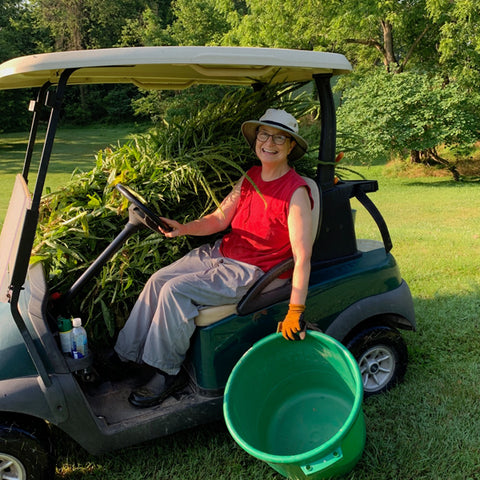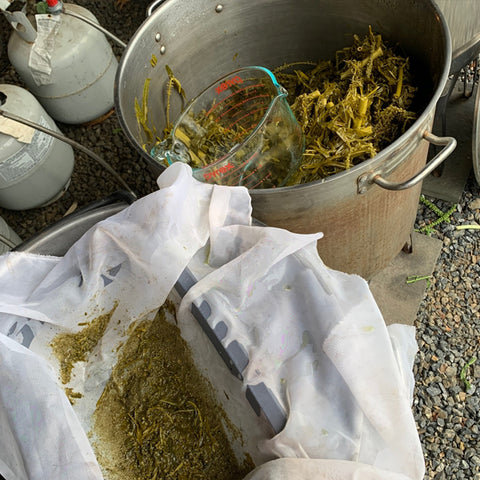dyeing from the garden: weld
My first experience with weld was a good long while ago when I was just learning about natural dyes. I got a call from a shepherd friend (Rebecca Brouwer from Shepherds Corner farm to fashion) asking if I wanted some weld to dye with; it was out of control and she was pulling it all out from her gardens (which were very large and beautiful!). I said “sure, I'll be right there.” There was a LOT of weld in her garden! We completely filled the back of my pick-up (up to it's cap) with the long stalks. I knew nothing then. I came home, looked up weld in my dye books and only found it in one: Wild Color by Jenny Dean. I dyed a few skeins of yarn and was in love! It was the most fabulous, intense yellow green ever. I doubt most dyers ever have that much weld to work with to get that intensity. It was amazing!
I have wanted to re-create that experience ever since. I tried to grow it here in a bed far from our kitchen garden (knowing from Rebecca’s desire to destroy it... how it could take over completely) but I could not get it going. Then I tried buying a giant bag of dried weld and was completely disappointed in the dull yellow I got (side note: could have been that our water is too acidic from a recent post from Catharine Ellis).
Fast forward several years and I was lucky to take a two week natural dye class at Penland School of Craft in NC with Catharine Ellis and Joy Boutrup (the whole thing was amazing!). Catharine brought us a big bunch of weld from her garden. The class split up to experiment with different dyes and I volunteered to work with the weld. Still loved it. I told Catharine that I hadn't had any luck with seeds and she suggested that I plant in mid-summer when the plant popped it's seeds naturally. Later she mailed me seeds she saved from her garden. So to shorten this long story a little... the magic seeds germinated and grew! Weld is a biennial. The first summer you get short rosette shaped plants. The second year it shoots up a very tall flower stalk, and this is what you use for dyeing.
If you follow Solitude Wool on Instagram, you saw it happen blow by blow the last week in June. Probably thanks to the pandemic...and social media accountability...I actually focused all week and got the job done (even clean up!).
So here is the process:
1. harvest early Monday morning in the fog. Thought it was going to fit in a muck bucket...HA!


2. chop it up as small as your hands and patience will go

3. put it in a pot (I filled two 80 quart pots and still had some left over)

3. In a third, even bigger pot I heated water to boiling. Poured that over the weld in each pot and let it steep for a few hours. That afternoon I brought them to a simmer for an hour. It’s important not to let weld boil because that kills the bright clear yellow. Turned it off and let it sit overnight.
4. Tuesday morning I strained off the liquid from both weld pots combining it in a third and larger 100 quart pot

5. now the fun part! Add yarn. This is the Tunis 3 ply. It had been pre-mordanted with alum, and wetted overnight.

I brought it up to a simmer again for about an hour and then let it sit the rest of the day and overnight to get maximum yellow. It is so clear!
6. I still had the cooked weld in two pots. Next day, I added in the remaining weld that hadn't fit the first time and bailed the dye bath back into each of the two pots to extract any remaining dye from the plants. Brought them up to a simmer for about an hour and let it steep overnight.

7. Wednesday morning I strained the liquid from both pots back into the third big one for more yarn dyeing

8. Next up: a batch of Tunis 3 ply that had been underwhelmingly dyed with indigo the previous fall. It was weak and uneven and only fit to be overdyed. I wetted it and added it to the dye bath knowing that it wasn't mordanted.

here it is dyed in weld, still very underwhelming:

and then pop it into a copper (mordant) afterbath and presto changeo!

beautiful! Mordants, although the most toxic part of dyeing I do...is necessary. It also improves lightfastness. You can sometimes add the mordant to the dye bath itself, but then some of the dye attaches to the mordant before it can attach to the yarn and you waste dye. Plus, then you no longer have the option to use a different mordant.
Each time you use the dye bath, a portion of the dye attaches to the yarn, so the dye bath gets lighter and less potent with each dye lot.
9. Thursday: one more batch of yarn, a small batch of white Icelandic that had been pre-mordanted with alum. I also put that in the copper afterbath to green it up (copper does that).

10. last, Thursday afternoon: dyed two 4 oz batches of Clun Forest roving (one in each pot) to suck up more dye and also put that in the copper afterbath.

11. remember the weld plants? cooked they shrunk quite a bit, but still I had bunch ready to take to the compost pile...and the circle of the dye garden continues.

Here is the fabulous results of a weeks work:
12. Do you want to grow some? I saved some seed and will mail it to the people as long as it lasts. Email me with your name and address. I'll send you some.
Plant it NOW (mid summer). It likes sandy open soil and I suggest if you don't want to battle it in a couple years...because it does self sow very successfully, put it somewhere where you don't mind it spreading. It doesn't like to be transplanted, so sow directly and then keep it weeded.

If you don’t have a safe place to grow weld, or just don’t want to wait...you can buy some yarn from us! The Tunis 3 ply qualifies for Shave em to Save ’em too. See how yellow and green bring the palette of natural dyed colors to life. Just one stripe of either of those in color work will make the whole project sing!






Comments (0)